TO
| Creator | Title | Description | Subject | Date | ||
|---|---|---|---|---|---|---|
| 1 |
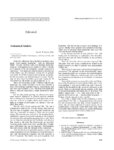 | Kestle, John R. W. | Abdominal binders | Sklar and colleagues2 describe their experience managing "over-shunting headaches" with an abdominal binder. Seventy children with over-shunting headaches complied with application of a binder for about 1 month. In 61 patients (87%), the headaches "greatly improved or went away." This headache relie... | 2012-01-01 | |
| 2 |
 | Kestle, John R. W.; Walker, Marion L. | Adjustment and malfunction of a programmable valve after exposure to toy magnets | Inadvertent adjustments and malfunctions of programmable valves have been reported in cases in which patients have encountered powerful electromagnetic fields such as those involved in magnetic resonance imaging, but the effects of small magnetic fields are not well known. The authors present a ca... | 2004 | |
| 3 |
 | Dailey, Andrew T. | Agreement between orthopedic surgeons and neurosurgeons regarding a new algorithm for the treatment of thoracolumbar injuries: a multicenter reliability study | Introduction: Considerable variability exists in the management of thoracolumbar (TL) spine injuries. Although there are many influences, one significant factor may be the treating surgeon's specialty and training (ie, orthopedic surgery vs. neurosurgery). Our objective was to assess the agreement ... | Thoracolumbar injuries; Rating; Classification; TLISS; Neurosurgery; Interspeciality reliability | 2006 |
| 4 |
 | Dailey, Andrew T.; Brodke, Darrel S.; Bachus, Kent N. | Anterior cervical fixation: analysis of load-sharing and stability with use of static and dynamic plates | Background: Anterior plates provide stability following decompression and fusion of the cervical spine. Various plate designs have emerged, and they include static plates with fixed-angle screws, rotationally dynamic plates that allow the screws to toggle in the plate, and translationally dynamic pl... | Anterior cervical fixation; Load-sharing; Stability; Static plates; Dynamic plates | 2006 |
| 5 |
 | Dailey, Andrew T.; Schmidt, Meic H.; Apfelbaum, Ronald I. | Anterior fixation of odontoid fractures in an elderly population | Object. Fractures of the odontoid process are the most common fractures of the cervical spine in patients over the age of 70 years. The incidence of fracture nonunion in this population has been estimated to be 20-fold greater than that in patients under the age of 50 years if surgical stabilizatio... | Odontoid fractures; Elderly population; Anterior fixation | 2010 |
| 6 |
 | Kestle, John R. W. | Assessing the validity of the endoscopic shunt insertion trial: did surgical experience affect the results? | Object. Most surgical procedures are associated with a learning curve in which the success rate is lower early in the experience before mistakes have been identified and modifications made to the procedure. Negative results obtained early in a trial's learning curve may be a matter of timing rather ... | Endoscopic shunt insertion; Ventriculoperitoneal shunt; Pediatric neurosurgery; Surgical experience | 2004-01-01 |
| 7 |
 | Couldwell, William T. | Assessment of long-term remission of acromegaly following surgery | Object. The criteria for remission of acromegaly following transsphenoidal adenoma resection are in evolution. In the present study the authors evaluate the utility of predicting long-term remission by reference to a single fasting growth hormone (GH) level on the 1st postoperative day. Methods. A ... | Acromegaly; Pituitary adenoma; Transsphenoidal surgery; Growth hormone; Insulin-like growth factor I | 2003-01-01 |
| 8 |
 | Schmidt, Meic H. | Assessment of the reliability of the Enneking and Weinstein-Boriani-Biagini classifications for staging of primary spinal tumors by the spine oncology study group | Despite advances in the treatment of primary spinal tumors in recent years, the with respect to the feasibility of oncologically appropriate surgical treatment and the selection of the optimal surgical approach. These tumors are relatively rare, comprising 11% of all primary musculoskeletal tumors a... | 2009-01-01 | |
| 9 |
 | Couldwell, William T. | Astrocytoma cell line | TO THE EDITOR: It has long been established clinically that patients with neurofibromatosis Type 1 (NF1) have an increased susceptibility to develop many central and peripheral tumors. The nature of the genetic alterations underlying NF1 have recently begun to be characterized. It has been demo... | 2001 | |
| 10 |
 | Schmidt, Meic H.; Apfelbaum, Ronald I. | Atlantoaxial transarticular screw fixation: a review of surgical indications, fusion rate, complications, and lessons learned in 191 adult patients | Object. In this, the first of two articles regarding C1-2 transarticular screw fixation, the authors assessed the rate of fusion, surgery-related complications, and lessons learned after C1-2 transarticular screw fixation in an adult patient series. Methods. The authors retrospectively reviewed 191 ... | Atlantoaxial junction; Craniocervical junction; Instability; Transarticular screw fixation; Fusion | 2005 |
| 11 |
 | Schmidt, Meic H. | Benzoporphyrin derivative and light-emitting diode for use in photodynamic therapy: applications of space light-emitting diode technology | Photodynamic therapy (PDT) is a cancer treatment modality that recently has been applied as adjuvant therapy for rain tumors. PDT consists of intravenously injecting a photosensitizer, which preferentially accumulates in tumor ells, into a patient and then activating the photosensitizer with a light... | Benzoporphyrin; Photodynamic therapy; Brain tumors; Photofrin | 1998 |
| 12 |
 | Couldwell, William T.; Orlandi, Richard R. | Carotid artery-sparing repair of a cavernous carotid artery pseudoaneurysm | Carotid artery (CA) injury after transsphenoidal and endoscopic sinus surgery is a well-recognized but fortunately rare complication.1 It is associated with significant morbidity and mortality rates5 and is more common in cases of repeated surgery, cavernous sinus invasion, prior radiotherapy, and ... | Carotid artery; Sinus; Pseudoaneurysm; Endoscopic surgery | 2006 |
| 13 |
 | Schmidt, Meic H. | Castleman disease of the spine mimicking a nerve sheath tumor | Castleman disease is a rare lymphoproliferative disease of unknown cause. In most cases, afflicted patients present with a mediastinal mass although the disease may manifest in numerous other sites, including intracranially and rarely intraspinally. The authors report on the case of a 19-year-old wo... | Castleman disease; Nerve sheath tumor | 2007 |
| 14 |
 | Gluf, Wayne M.; Gottfried, Oren N.; Schmidt, Meic H. | Cavernous hemangioma of the skull presenting with subdural hematoma | Cavernous hemangioma of the calvarium is a very rare disease, and patients usually present with headaches or a visible skull deformity. Few reports of patients presenting with intradiploic or epidural hemorrhages are found in the literature. No cases of an intradural hemorrhage from a cavernous hema... | Hemangioma, Cavernous; Skull; Hematoma, Subdural | 2004-07-15 |
| 15 |
 | Schmidt, Meic H. | Cavernous hemangioma of the skull presenting with subdural hematoma | Cavernous hemangioma of the calvaria is a very rare disease, and patients usually present with headaches or a visible skull deformity. Few reports of patients presenting with intradiploic or epidural hemorrhages are found in the literature. No case of an intradural hemorrhage from a cavernous hemang... | Calvaria; Cavernous hemangioma | 2004 |
| 16 |
 | Couldwell, William T.; Jensen, Randy L.; Gillespie, David L. | Celecoxib inhibits meningioma tumor growth in a mouse xenograft model | Background: Treatments for recurrent meningiomas are limited. We previously demonstrated universal expression of COX-2 in meningiomas and dose-dependent growth inhibition in vitro with celecoxib, a COX-2 inhibitor. We therefore tested the effects of celecoxib on meningioma growth in a mouse xenograf... | Meningioma; Cyclooxygenase-2; COX-2; Celecoxib | 2007 |
| 17 |
 | Jaeckle, Kurt A.; Digre, Kathleen B.; Jones, Christopher R.; Bailey, Peter L. | Central neurogenic hyperventilation: pharmacologic intervention with morphine sulfate and correlative analysis of respiratory, sleep, and ocular motor dysfunction. | Central neurogenic hyperventilation (CNH), for which there is no effective therapy, can eventually result in respiratory fatigue and death. This report describes a patient with CNH due to a brainstem anaplastic astrocytoma who also exhibited disturbances of sleep and ocular motor function. The CNH r... | Central Neurogenic H yperventilation; Ocular Motor Dysfunction | 1990-11 |
| 18 |
 | Kestle, John R. W. | Cerebrospinal fluid shunt technology | Since the invention of the first implantable shunt valve by Nulsen and Spitz (12) almost 50 years ago, there has been a remarkable number of ingenious modifications and new designs of shunt equipment to treat pediatric hydrocephalus. These developments were in response to the immediately evident hi... | Shunt technology; Valve design | 2000 |
| 19 |
 | Dailey, Andrew T.; Brodke, Darrel S. | Cervical end of an occipitocervical fusion: a biomechanical evaluation of 3 constructs | Object. Stabilization with rigid screw/rod fixation is the treatment of choice for craniocervical disorders requiring operative stabilization. The authors compare the relative immediate stiffness for occipital plate fixation in concordance with transarticular screw fixation (TASF), C-1 lateral mass... | Harms technique; Occipitocervical fusion; Transarticular screw; Translaminar screw; Craniocervical instability | 2008 |
| 20 |
 | Schmidt, Meic H.; Apfelbaum, Ronald I. | Cervical spinal metastasis: anterior reconstruction and stabilization techniques after tumor resection | Object. In a review of the literature, the authors provide an overview of various techniques that have evolved for reconstruction and stabilization after resection for metastatic disease in the subaxial cervical spine. Methods. Reconstruction and stabilization of the cervical spine after vertebral... | Cervical spine reconstruction; Metastasis; Spine tumor; Corpectomy; Stabilization technique; Vertebral body | 2003 |
| 21 |
 | Schmidt, Meic H. | Cervical spine deformity associated with resection of spinal cord tumors | Postoperative sagittal-plane cervical spine deformities are a concern when laminectomy is performed for tumor resection in the spinal cord. These deformities appear to occur more commonly after resection of intramedullary spinal cord lesions, compared with laminectomy for stenosis caused by degener... | Kyphosis; Cervical deformity; Intramedullary tumor; Laminectomy; Children | 2006 |
| 22 |
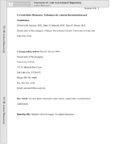 | Schmidt, Meic H. | Cervical spine metastases: techniques for anterior reconstruction and stabilization | The surgical management of cervical spine metastases continues to evolve and improve. The authors provide an overview of the various techniques for anterior reconstruction and stabilization of the subaxial cervical spine after corpectomy for spinal metastases. Vertebral body reconstruction can be ac... | 2012-01-01 | |
| 23 |
 | Kestle, John R. W. | Change in ventricular size and effect of ventricular catheter placement in pediatric patients with shunted hydrocephalus | OBJECTIVE: The multicenter, randomized pediatric cerebrospinal fluid shunt valve design trial found no difference in the rate of shunt failure between a standard valve, a siphon-reducing valve (Delta; Medtronic PS Medical, Goleta, CA), and a flow-limiting valve (Orbis Sigma; Cordis, Miami, FL); ho... | Shunt failure; Valve design; Ventricular size; Ventricular catheter placement | 1999 |
| 24 |
 | Couldwell, William T. | Cholesteatoma of the clivus case report | Objective: Cholesteatomas (CNS epidermoids) can be found intradurally or extradurally in the central nervous system. Extradural intraosseous lesions are most commonly found in the petrous bone. Design: Case report Clinical Presentation: The authors describe a unique case of a clival cholesteatoma o... | 2006-01-01 | |
| 25 |
 | Couldwell, William T. | Choroid plexus cyst development and growth following ventricular shunting | Choroid plexus cysts are typically incidental, asymptomatic cysts. They have been reported to hemorrhage and grow, causing symptoms of obstruction. However, growth and multiplication has not been reported following ventriculoperitoneal shunting procedures. A 66-year-old woman initially underwent a ... | Choroid plexus cyst; Ventriculoperitoneal shunt | 2008-01 |
| 26 |
 | Schmidt, Meic H.; Apfelbaum, Ronald I. | Chylorrhea: a rare complication of thoracoscopic discectomy of the thoracolumbar junction | The thoracic duct along with the cisterna chyli is a major lymphatic pathway near the anterior thoracolumbar spine. Despite the fragile nature of the lymphatic system and its proximity to the spinal column, chylorrhea is rarely encountered by spine surgeons. The authors present a unique case of chyl... | Chylous leak; Thoracoscopy; Thoracic spine; Thoracoscopic discectomy; Thoracolumbar junction; Chylorrhea | 2007 |
| 27 |
 | Couldwell, William T. | Clinical and radiographic response in a minority of patients with recurrent malignant gliomas treated with high-dose tamoxifen | PREVIOUS WORK HAS demonstrated the importance of the Protein Kinase C (PKC) signal transduction system in regulating the growth rate of malignant gliomas in vitro. Tamoxifen inhibits PKC in a minority of malignant gliomas within the micromolar concentration range in vitro, a property distinct from... | Tamoxifen; Protein kinase C; Glioma; Brain neoplasm; Chemotherapy; Glioma | 1993 |
| 28 |
 | Couldwell, William T. | Combined transmastoid retro- and infralabyrinthine transjugular transcondylar transtubercular high cervical approach for resection of glomus jugulare tumors | COMPLEX TUMORS OF the glomus jugulare present a surgical challenge because of their difficult location, extreme vascularity, and involvement with multiple cranial nerves. Modern microneurosurgical and cranial base techniques have enabled safe total removal of these complicated tumors. We describe a ... | Cranial base approach; Surgical approach; Glomus jugulare tumor; Jugular foramen exposure; Microsurgical anatomy | 2006 |
| 29 |
 | Couldwell, William T. | Comment on Aydin, K., et al: Localization of cerebrospinal fliud leaks by gadolinium-enhanced magnetic resonance cisternography: a 5-year single-center experience | The Author's describe the use of intrathecal Gd-enhanced MR cisternography for the definition of cerebrospinal fluid leaks in 51 patients. They were able to identify the site of leak in 43 of 51 patients (84%). Although the technique is not new, most of the previous articles are found in the neuror... | Cerebrospinal fluid leaks | 2007 |
| 30 |
 | Couldwell, William T. | Comment on Kitano, M. and Taneda, M.: Extended transsphenoidal approach to the anterior communicating artery aneurysm: aneurysm incidentally identified during macroadenoma resection | Kitano and Taneda describe the successful clipping of an ACoA aneurysm via the transsphenoidal approach. There are limitations of the approach; most notable are the limited and narrow corridor and the relationship between the aneurysm and the optic chiasm, which may hinder full visualization of the ... | Aneurysm; Transsphenoidal approach | 2007 |
| 31 |
 | Couldwell, William T. | Comment on Kitano, M., et al.: Subdural patch graft technique for watertight closure of large dural defects in extended transsphenoidal surgery | Ahn and Kim demonstrate a suturing technique to close dural defects after transsphenoidal and extended transsphenoidal approaches. The technique entails a specifically designed forceps to cinch the knot down in the depths of the field. The Author's used the technique in 21 consecutive patients (16 e... | Transsphenoidal surgery; CSF leaks | 2009 |
| 32 |
 | Couldwell, William T. | Comment on Nugent, G. R.: Targeting the ventral lateral nucleus of the thalamus: a stereotactic vignette | Dr. Nugent provides a fascinating personal account of his early experience with stereotactic surgery for movement disorders. I was especially pleased to read the positive comments regarding the personal interactions with and innovations of Irving Cooper, a neurosurgeon who was derided by his peers b... | Stereotactic surgery; Stereotaxis | 2006 |
| 33 |
 | Couldwell, William T. | Comment on Wong, H. T., et al.: Comparative impact of video consultation on emergency neurosurgical referrals | The Author's explored the facility and accuracy of telephone, teleradiology, or video consultation between a large general hospital and their tertiary neurosurgical center. Although there was increased diagnostic accuracy with video consultation or teleradiology, they note that consultation via vid... | Teleradiology; Video consultation; Neurosurgical referrals | 2006 |
| 34 |
 | Couldwell, William T. | Comment on: Chronic brain inflammation and persistent herpes simplex virus 1 thymidine kinase expression in survivors of syngeneic glioma treated by adenovirus-mediated gene therapy: implications for clinical trials | The long-term consequences of adenovirus-mediated conditional cytotoxic gene therapy for gliomas remain uncharacterized. We report here detection of active brain inflammation 3 months after successful inhibition of syngeneic glioma growth. The inflammatory infiltrate consisted of activated macrophag... | Brain inflammation; Herpes simplex virus-1; Thymidine kinase; Syngeneic glioma; Adenovirus-mediated gene therapy | 1994 |
| 35 |
 | Couldwell, William T. | Communication between malignant glioma cells and vascular endothelial cells through gap junctions | Object. Extensive invasion and angiogenesis are hallmark features of malignant gliomas. Communication between malignant glioma cells and surrounding astrocytes occurs, resulting in transformation of the astrocytic phenotype. In the present study, the authors examined whether malignant glioma cells a... | 2003-01-01 | |
| 36 |
 | Kestle, John R. W. | Comparison between magnetic resonance imaging and computed tomography for stereotactic coordinate determination | The spatial accuracy of magnetic resonance imaging (MRI) has not been established for stereotactic surgery. Magnetic susceptibility artifacts may lead to anatomical distortion and inaccurate stereotactic MRI coordinates, especially when targets are in regions of the brain out of the center of the ma... | Computed tomography; Stereotactic coordinates; Stereotactic surgery | 1992 |
| 37 |
 | Dailey, Andrew T.; Brodke, Darrel S. | Comparison of computerized tomography and direct visualization in thoracic pedicle screw placement | Object. To validate computerized tomography (CT) scanning as a tool to assess the accuracy of thoracic pedicle screw placement, the authors compared its accuracy with that of direct visualization in instrumented cadaveric spine specimens. Methods. A grading scale was devised to score the placement... | Computerized tomography; Direct visualization; Thoracic pedicle screw; Pedicle; Thoracic spine | 2002 |
| 38 |
 | Couldwell, William T. | Comparison of radiosurgery and conventional surgery for the treatment of glomus jugulare tumors | Object. The optimal management of glomus jugulare tumors remains controversial. Available treatments were once associated with poor outcomes and significant complication rates. Advances in skull base surgery and the delivery of radiation therapy by stereotactic radiosurgery have improved the results... | 2004 | |
| 39 |
 | Gottfried, Oren N.; Liu, James K.; Couldwell, William T. | Comparison of radiosurgery and conventional surgery for the treatment of Glomus Jugulare tumors | Objective: The optimal management of glomus jugulare tumors remains controversial. Available treatments were once associated with poor outcomes and significant complication rates. Advances in skull base surgery and the delivery of radiation therapy by stereotactic radiosurgery have improved the resu... | Glomus Jugulare; Radiosurgery; Radiotherapy; Skull Base; Surgery | 2004-07-07 |
| 40 |
 | Couldwell, William T.; Gillespie, David L.; Jensen, Randy L. | Comparison of the cell lines used in meningoma research | Background: Immortal cell lines and cell lines derived from operative specimens transplanted into animal models are used in meningioma research. We address two criticisms of the mouse xenograft flank tumor model: Why are tumor induction rates derived from operative specimens low and inconsistent? Ar... | CH-157 MN; IOMM-Lee; Meningioma; Xenograft Mouse Model; Flank tumors | 2008 |
| 41 |
 | Dailey, Andrew T. | Complement depletion reduces macrophage infiltration and activation during Wallerian degeneration and axonal regeneration | After peripheral nerve injury, macrophages infiltrate the degenerating nerve and participate in the removal of myelin and axonal debris, in Schwann cell proliferation, and in axonal regeneration. In vitro studies have demonstrated the role serum complement plays in both macrophage invasion and activ... | 1998 | |
| 42 |
 | Kestle, John R. W.; Brockmeyer, Douglas Lee | Complications of intracranial pressure monitoring in children with head trauma | Object. Intracranial pressure (ICP) monitoring has become routine in the management of patients with traumatic brain injury (TBI). Many surgeons prefer to use external ventricular drains (EVDs) over fiberoptic monitors to measure ICP because of the added benefit of cerebrospinal fluid drainage. The ... | Head trauma; Ventriculostomy; External ventricular drain; Monitoring; Fiberoptic monitor | 2004 |
| 43 |
 | Digre, Kathleen B.; Schmidt, Richard H.; Osborne, Anne G.; Patel, Bhupendra C.; Pratt, David; Rietz, Lisa A. | Compressive optic neuropathy caused by renal osteodystrophy. Case report. | Compressive optic neuropathy with acute or chronic vision loss has been associated with various skull base tumors, aneurysms, Graves disease, trauma, and, less commonly, fibrous dysplasia and osteopetrosis. The Author's present a case of acute visual deterioration in a 25-year-old woman who had mass... | Optic Neuropathy; Optic Nerve Decompression; Renal Osteodystrophy | 2001-10 |
| 44 |
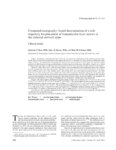 | Bisson, Erica F. | Computed tomography-based determination of a safe trajectory for placement of transarticular facet screws in the subaxial cervical spine: Clinical article | Object. Placement of transarticular facet screws is one option for stabilization of the subaxial cervical spine. Small clinical series and biomechanical data support their role as a substitute for other posterior stabilization techniques; however, the application of transarticular facet screws in th... | 2012-01-01 | |
| 45 |
 | Couldwell, William T. | Conflict and opportunity: neurosurgery and industry | The relationship between neurosurgery and industry is multifaceted. Most aspects of this relationship promote the advancement of a highly technical field such as neurosurgery, helping neurosurgeons bring ever more effective therapies to their patients. However, serious ethical and legal concerns a... | 2007-01-01 | |
| 46 |
 | Couldwell, William T. | Cosmetic mastoidectomy for the combined supra/infratentorial transtemporal approach | The authors describe a cosmetic mastoidectomy technique for use when performing a combined supra/ infratentorial craniotomy and transtemporal exposure. The technique involves a single temporal suboccipital bone flap and cosmetic mastoidectomy, removing the outer table of bone for later replacement... | Surgical approach; Supratentorial approach; Infratentorial approach; Petroclival meningiomas | 1993 |
| 47 |
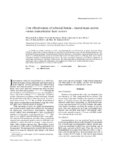 | Bisson, Erica F. | Cost effectiveness of subaxial fusion-lateral mass screws versus transarticular facet screws | As health care reform continues to evolve, demonstrating the cost effectiveness of spinal fusion procedures will be of critical value. Posterior subaxial cervical fusion with lateral mass screw and rod instrumentation is a wellestablished fixation technique. Subaxial transarticular facet fixation is... | 2012-01-01 | |
| 48 |
 | Kestle, John R. W. | Cost-effectiveness analysis of endoscopic third ventriculostomy | OBJECTIVE: Endoscopic third ventriculostomy (ETV) is currently the principal alternative to cerebrospinal fluid shunt placement in the management of pediatric hydrocephalus. Cost-effectiveness analysis can help determine the optimal strategy for integrating these different approaches. METHODS: All... | Endoscopic third ventriculostomy; ETV | 2002 |
| 49 |
 | Kestle, John R. W.; Brockmeyer, Douglas Lee | Cranial base strategies for resection of craniopharyngioma in children | The optimal treatment of craniopharyngioma in children remains a challenge. The use of complete excision to minimize recurrence continues to be controversial because of the risk of postoperative morbidity and death. Advances in skull base approaches, modern microsurgical techniques, neuroimaging, an... | Craniopharyngioma; Surgical approach; Skull base surgery | 2005 |
| 50 |
 | Couldwell, William T. | Cranioplasty with the Medpor porous polyethylene Flexblock implant | The authors describe the use of a porous polyethylene Flexblock implant for cosmetic cranioplasty. The implant may be used to cover any small- or medium-sized (< 8 cm) cranial defect, offering similar cosmetic results to standard alloplast cranioplasty while decreasing operation time. The porous i... | Cranioplasty; Medpor; Alloplast; Polyethylene; Skull defect | 1994 |
| 51 |
 | Couldwell, William T.; House, Paul A. | De novo fenestration of the optic nerve | Fenestration of the optic nerve or chiasm due to the presence of an aneurysmal dilation of the internal carotid artery (ICA) has been described previously. In three of five cases reviewed recently, the optic nerve was penetrated by an ICA?ophthalmic artery aneurysm.3 Penetration of the optic nerve w... | Fenestration; Aneurysm | 2005 |
| 52 |
 | House, Paul A.; Couldwell, William T. | De novo fenestration of the optic nerve case illustration. | Fenestration of the optic nerve or chiasm due to the presence of aneurismal dilation of the internal carotid artery (ICA) has been described. In three out of five cases reviewed recently, the optic nerve was penetrated by an ICAΓÇôophthalmic artery aneurysm.3 Penetration of the optic nerve was du... | Aneurysm; Congenital Optic Nerve | 2005-02-01 |
| 53 |
 | Kestle, John R. W. | Death after late failure of third ventriculostomy in children | Late failure following successful third ventriculostomy for obstructive hydrocephalus is rare, and death caused by failure of a previously successful third ventriculostomy has been reported only once. The authors present three patients who died as a result of increased intracranial pressure (ICP) a... | Ventriculostomy; Obstructive hydrocephalus; Late failure; Death | 2002 |
| 54 |
 | Couldwell, William T.; Apfelbaum, Ronald I. | Decompression of cavernous sinus meningioma for preservation and improvement of cranial nerve function | Meningiomas are the most common tumors affecting the cavernous sinus (CS). Despite advances in microsurgery and radiosurgery, treatment of CS meningiomas remains difficult and controversial. As in cases of other meningiomas, the goal of treatment for CS meningioma is long-term growth control and pre... | 2006-07 | |
| 55 |
 | Couldwell, William T. | Defining postoperative values for successful resection of prolactinomas | We, as other authors, have noted that late relapse of hyperprolactinemia following apparent successful adenomectomy in women harboring microprolactinomas is not rare.[1-3] On retrospective review of a series of tumors treated at the University of Southern California teaching hospitals, we have foun... | Hyperprolactinemia; Microadenoma; Prolactin | 1996 |
| 56 |
 | Couldwell, William T. | Definition of the role of contemporary surgical management in cisternal and parenchymatous cysticercosis cerebri | With increasing immigration from endemic regions, the incidence of neurocysticercosis in North America is rising. This retrospective study was undertaken to examine the role of surgery in those cases presenting with large cystic parenchymal and cisternal lesions in the current era of anthelminthic a... | Brain cyst; Computed tomography; Neurocysticercosis; Magnetic resonance imaging; Praziquantel; Stereotaxis | 1991 |
| 57 |
 | Couldwell, William T. | Delayed vasospasm after removal of a skull base meningioma | Cerebral vasospasm is a well-known clinical entity associated with subarachnoid hemorrhage and traumatic brain injury [1,2]. In rare instances, vasospasm has been reported to occur after tumor resections, more specifically, after skull base tumor removal [3-5]. We report a rare case of a patient pre... | 2012-01-01 | |
| 58 |
 | Kestle, John R. W. | Determining the best cerebrospinal fluid shunt valve design: the pediatric valve design trial | Myriad cerebrospinal fluid shunt valve designs are available (17, IS). None has ever been shown to be superior to another, although claims by neurosurgeons and shunt manufacturers of the merits of particular designs are numerous. Such is the case with two recent shunt valve designs, the Orbis-Sigm... | Pediatric valve design; Shunt valves | 1996 |
| 59 |
 | Couldwell, William T.; Jensen, Randy L.; Jensen, Elizabeth M. | Development of contrast enhancement after long-term observation of a dysembryoplastic neuroepithelial tumor | Dysembryoplastic neuroepithelial tumors (DNET) are usually benign lesions that arise in cortical regions and are discovered after new onset of seizure. These lesions have many different imaging characteristics. We report a patient with a presumed low-grade medial temporal lobe lesion that was follow... | Brain tumor; Dysembryoplastic neuroepithelial tumors; DNET; Imaging; Seizures | 2006 |
| 60 |
 | Couldwell, William T. | Development of neurosurgery in Southern California and the Los Angeles County/University of Southern California Medical Center | The Los Angeles County General Hospital has played an integral role in the development of medicine and neurosurgery in Southern California. From its fledgling beginnings, the University of Southern California School of Medicine has been closely affiliated with the hospital, providing the predomina... | Historical vignette; Los Angeles County General Hospital; University of Southern California School of Medicine; Neurosurgical history | 1993 |
| 61 |
 | Couldwell, William T. | Diagnosis and management of Cushing disease | The management of a case involving Cushing disease, defined as excess secretion of adrenocorticotropic hormone (ACTH) from a pituitary adenoma, remains one of the most vexing problems facing the pituitary surgeon. The systemic consequences of this endocrinopathy are profound morbidity and premature... | 2007-01-01 | |
| 62 |
 | Schmidt, Meic H. | Diagnosis and management of sacral Tarlov cysts | Perineurial (Tarlov) cysts are meningeal dilations of the posterior spinal nerve root sheath that most often affect sacral roots and can cause a progressive painful radiculopathy. Tarlov cysts are most commonly diagnosed by lumbosacral magnetic resonance imaging and can often be demonstrated by com... | Tarlov cysts; Meningeal dilations; Spinal lesion; Outcome | 2003 |
| 63 |
 | Dailey, Andrew T. | Diagnosis and treatment of craniocervical dislocation in a series of 17 consecutive survivors during an 8-year period | Object. Craniocervical dissociation (CCD) is a highly unstable and usually fatal injury resulting from osseoligamentous disruption between the occiput and C-2. The purpose of this study was to elucidate systematic factors associated with delays in diagnosing and treating this life-threatening condit... | Spinal cord injury; Craniocervical dislocation; Atlantooccipital joint; Atlantoaxial joint; Tetraplegia; CCJ; CCD | 2006 |
| 64 |
 | Dailey, Andrew T.; Brodke, Darrel S. | Differences between neurosurgeons and orthopaedic surgeons in classifying cervical dislocation injuries and making assessment and treatment decisions: a multicenter reliability study | Variability exists in the management of cervical spinal injuries. The goal of this study was to assess the effect of training specialty (orthopedic surgery vs neurosurgery) on management of cervical dislocations. | Cervical dislocation injuries; Classification; Orthopedic surgeons; Orthopaedic surgeons; Assessment decisions; Treatment decisions | 2008 |
| 65 |
 | Schmidt, Meic H. | Diffuse large B-cell lymphoma presenting as a sacral tumor | Primary lymphomas of the sacrum are rare tumors, reported only in a few cases in the literature. The authors describe two patients with diffuse large B-cell lymphomas presenting as a sacral tumor. In the first case a 52-year-old man presented with progressive back pain, bilateral radicular pain, an... | B-cell lymphoma; Sacral tumor | 2003 |
| 66 |
 | Couldwell, William T.; Gottfried, Oren N. | Distal ventriculoperitoneal shunt failure secondary to clostridium difficile colitis | Distal ventriculoperitoneal shunt obstruction is typically associated with cerebrospinal fluid (CSF) infection, fluid pseudocysts, bowel obstruction, bowel perforation, or improper shunt placement in the abdomen. We describe a unique etiology for distal shunt obstruction secondary to Clostridium di... | 2005-01-01 | |
| 67 |
 | Couldwell, William T. | Distal ventriculoperitoneal shunt failure secondary to Clostridium Difficile Colitis | Distal ventriculoperitoneal shunt obstruction is typically associated with cerebrospinal fluid (CSF) infection, fluid pseudocysts, bowel obstruction, bowel perforation, or improper shunt placement in the abdomen. We describe a unique etiology for distal shunt obstruction secondary to Clostridium dif... | Shunt Failure | 2005-03 |
| 68 |
 | Kestle, John R. W. | Does thalamotomy alter the course of Parkinson's disease? | Irving Cooper (3) observed that unilateral Parkinson's disease seemed less likely to progress to the other side of the body after thalamotomy that abolished contralateral tremor and rigidity, an effect that he felt might be the result of either the surgery itself or the slow progression of that par... | 1996 | |
| 69 |
 | Dailey, Andrew T.; Brodke, Darrel S. | Dynamic cervical plates: biomechanical evaluation of load sharing and stiffness | Study Design. An in vitro biomechanical study using a simulated cervical corpectomy model to compare the load-sharing properties and stiffnesses of two static and two dynamic cervical plates. Objectives. To evaluate the load-sharing properties of the instrumentation with a full-length graft and... | In vitro biomechanical study; Cervical corpectomy; Cervical plates | 2001 |
| 70 |
 | Digre, Kathleen B.; Blumenthal, Deborah T.; Salzman, Karen L.; Jensen, Randy L.; Dunson, William A. | Early pathologic findings and long-term improvement in anti-Ma2-associated encephalitis. | A 67-year-old man sequentially developed anti-Ma2-associated paraneoplastic encephalitis (PNE) and contralateral herpes simplex encephalitis (HSE). Brain biopsy 1 month before HSE revealed extensive infiltrates of T cells, B cells, and plasma cells. Most T cells expressed the cytotoxic granule-assoc... | Paraneoplastic neurologic disorders; Encephalitis; Neoplasm;Herpes Simplex | 2006-07-11 |
| 71 |
 | Digre, Kathleen B.; Blumenthal, Deborah T.; Salzman, Karen L.; Jensen, Randy L.; Dunson, William A. | Early pathologic findings and long-term improvement in anti-Ma2-associated encephalitis. | A 67-year-old man sequentially developed anti-Ma2-associated paraneoplastic encephalitis (PNE) and contralateral herpes simplex encephalitis (HSE). Brain biopsy 1 month before HSE revealed extensive infiltrates of T cells, B cells, and plasma cells. Most T cells expressed the cytotoxic granule-assoc... | Paraneoplastic neurologic disorders; Encephalitis; Neoplasm;Herpes Simplex | 2006-07-11 |
| 72 |
 | Couldwell, William T. | Effect of absorbable topical hemostatic agents on the relaxation time of blood: an in vitro study with implications for postoperative magnetic resonance imaging | Absorbable topical hemostatic agents are commonly used in neurosurgery. In this study the authors examine the longitudinal relaxation time (T1) of blood in contact with these agents over time, measured in vitro, to determine if their presence could affect the interpretation of postoperative magneti... | Absorbable hemostatic agent; Collastat; Surgicel; Oxidized regenerated cellulose; Methemoglobin | 2001 |
| 73 |
 | Kestle, John R. W. | Effect of hyperventilation on regional cerebral blood flow in head-injured children | Objectives: To study cerebral blood flow and cerebral oxygen consumption in severe head-injured children and also to assess the effect of hyperventilation on regional cerebral blood flow. Design: Prospective cohort study. Setting: Pediatric intensive care unit at a tertiary-level university childre... | Cerebral blood flow; Head injury; Jugular venous oximetry; Xenon computed tomography scan; Head-injured children | 1997 |
| 74 |
 | Kestle, John R. W. | Effect of single-application topical ophthalmic anesthesia in patients with trigeminal neuralgia: a randomized double-blind placebo-controlled trial | To evaluate the reported benefit of ipsilateral single-application ophthalmic anesthetic eyedrops in patients with typical trigeminal neuralgia, a randomized double-blind placebo-controlled trial was performed. Fortyseven patients were randomly assigned to receive two drops of either proparacaine (... | Randomized trial; Ophthalmic anesthesia | 1994 |
| 75 |
 | Couldwell, William T. | Efficacy of clip-wrapping in treatment of complex pediatric aneurysms | Purpose: Pediatric aneurysms (PAs) are distinct from their adult counterparts with respect to typical location, aneurysm type, and known predisposing risk factors. Many strategies have been employed to treat PAs, but, although it has been used frequently in adults, clip-wrapping in pediatric patient... | 2012-01-01 | |
| 76 |
 | Kestle, John R. W.; MacDonald, Joel D.; Couldwell, William T. | Efficacy of multiple intraarterial papaverine infusions for improvement in cerebral circulation time in patients with recurrent cerebral vasospasm | Object. Cerebral vasospasm that is caused by aneurysmal subarachnoid hemorrhage and that is refractory to maximal medical management can be treated with selective intraarterial papaverine infusions. The effects of single papaverine treatments on cerebral circulation time are well known. The purpose ... | Cerebral vasospasm; Intraarterial papaverine infusions | 2004 |
| 77 |
 | Schmidt, Meic H. | Embolization of sacral tumors | The management of sacral tumors is challenging because of difficulties in accessing the lesion, the high rate of local recurrence, extensive vascularity causing significant intraoperative blood loss, resistance to radiation therapy, and risk of malignant transformation. Although surgery is the main ... | Sacral tumor | 2003 |
| 78 |
 | Dailey, Andrew T. | Emergent aneurysm clipping without angiography in the moribund patient with intracerebral hemorrhage: the use of infusion computed tomography scans | THE AUTHORS REPORT their experience with 25 patients (mean age, 44.3 ± 12.1 years) with an intracerebral hematoma (ICH) from a ruptured aneurysm who were emergently operated on without angiography. Instead, preoperative high-resolution infusion computed tomography (CT) scans were used to identify... | Ruptured aneurysms; Computed tomography; Infusion computed tomography; Aneurysm clipping | 1993 |
| 79 |
 | Couldwell, William T.; Orlandi, Richard R.; Jensen, Randy L. | Endoscopic-assisted craniofacial resection of esthesioneuroblastoma: minimizing facial incisions | The surgical management of esthesioneuroblastomas has traditionally been craniofacial resection, which combines a bifrontal craniotomy with a transfacial approach. The latter usually involves a disfiguring facial incision, mid-facial degloving, lateral rhinotomy, and/or extensive facial osteotomies... | Esthesioneuroblastoma; Craniofacial resection; Endoscope; Craniofacial surgery; Minimally invasive | 2003 |
| 80 |
 | Couldwell, William T. | Enhanced protein kinase C activity correlates with the growth rate of malignant gliomas in vitro | Direct measurement of protein kinase C (PKC) activity in vitro revealed a significant increase in the activity of the enzyme in all human malignant glioma lines examined and the rat C6 tumor in comparison with control nonneoplastic astrocyte and mixed glial cultures. The total and particulate PKC ac... | Brain neoplasms; Flow cytometry; Glioma; Phorbol ester; Protein kinase C | 1991 |
| 81 |
 | Kestle, John R. W.; Brockmeyer, Douglas Lee | Evaluation of the necessity of postoperative imaging after craniosynostosis surgery | Object. Childhood radiation exposure increases the lifetime risk of cancer from an estimated 0.07 to 0.35%. Neurological evaluation of patients after cranial vault reconstruction for synostosis repair is often complicated by pain medication, sedation, intubation, swelling, and dressings; therefore c... | Computed tomography; Cranial vault reconstruction; Pediatric neurosurgery; Radiation dose; Postoperative imaging | 2007 |
| 82 |
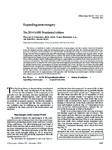 | Couldwell, William T. | Expanding neurosurgery | The history of medicine is replete with innovations in neurosurgery that have spurred further developments across the medical spectrum. Surgeons treating pathologies in the head and spine have broken ground with new approaches, techniques, and technologies since ancient times. Neurosurgeons occupy a... | 2014-01-01 | |
| 83 |
 | Couldwell, William T. | Experience with use of extended length peritoneal shunt catheters | The placement of a ventriculoperitoneal (VP) shunt is the current treatment of choice for diversion of cerebrospinal fluid associated with hydrocephalus. Although there are a host of reported potential abdominal complications related to the procedure, they are notably uncommon. The authors report t... | 1996 | |
| 84 |
 | Couldwell, William T.; Chin, Steven S. | Extranodal NK/T-cell lymphoma presenting as a pituitary mass | Extranodal NK/T-cell lymphomas are uncommon neoplasms that are highly aggressive and show a strong association with Epstein-Barr virus. They most commonly affect the nasal cavity and paranasal sinuses; manifestation as a primary pituitary tumor has never been described. The authors report a case of ... | 2007-09 | |
| 85 |
 | Couldwell, William T. | False-negative magnetic resonance angiography with extracranial internal carotid artery stenosis: a report of two cases and review of the literature | Magnetic resonance angiography (MRA) is increasingly used as a noninvasive means to assess internal carotid artery (ICA) stenosis. When used alone, however, MRA may not be sufficiently accurate in certain settings to determine whether ICA disease meets surgical criteria. Although MRA has been recogn... | Internal carotid artery stenosis; Magnetic resonance angiography | 2005 |
| 86 |
 | Couldwell, William T. | Far Lateral Transcondylar Approach for Resection of Neurenteric Cysts of the Cervicomedullary Junction (Far-lateral transcondylar approach: surgical technique and its application in neurenteric cysts of the cervicomedullary junction. Report of two cases.) | Neurenteric cysts are rare benign lesions of the central nervous system that are lined by endodermal cell-derived epithelium. Although they occur mostly in the spine, they can occur intracranially, most often in the posterior fossa. Neurenteric cysts that are located in the anterior cervicomedullary... | Cervical Vertebrae; Medulla Oblongata; Neural Tube Defects; Neurosurgical Procedure | 2005-08-15 |
| 87 |
 | Schmidt, Meic H.; Couldwell, William T. | Far lateral transcondylar transtubercular approach to lesions of the ventral foramen magnum and craniovertebral junction | The craniovertebral junction, which consists of the lower one third of the clivus, the foramen magnum, and the CI and C2 vertebrae, is a common site for neoplastic, vascular, congenital, and degenerative lesions of the cranial base. The far lateral transcondylar transtubercular approach (commonlyr... | Far-lateral; Transcondylar; Transtubercular; Ventral foramen magnum; Craniovertebral junction | 2007 |
| 88 |
 | Couldwell, William T. | Far-lateral transcondylar approach: surgical technique and its application in neurenteric cysts of the cervicomedullary junction | Neurenteric cysts are rare benign lesions of the central nervous system that are lined by endodermal cell-derived epithelium. Although they occur mostly in the spine, they can occur intracranially, most often in the posterior fossa. Neurenteric cysts that are located in the anterior cervicomedullary... | 2005 | |
| 89 |
 | Couldwell, William T. | Fenestration of the oculomotor nerve by a duplicated posterior cerebral artery and aneurysm | The authors report a case of a posterior cerebral artery aneurysm arising from an aberrant arterial branch that was found to be splitting the oculomotor nerve. This 63-year-old man presented with headaches, and CT imaging revealed subarachnoid hemorrhage primarily within the basilar cisterns. Formal... | 2009-01-01 | |
| 90 |
 | Schmidt, Meic H. | Frameless stereotactic image-guided C1-C2 transarticular screw fixation for atlantoaxial instability: review of 20 patients | Atlantoaxial instability can result from trauma, rheumatoid arthritis, congenital malformation, or tumor invasion. The goal of treatment is stabilization of the C1-C2 complex to prevent neurologic and neurovascular compromise. First described in 1987 by Magerl and Seemann, C1-C2 transarticular screw... | Transarticular screws; Atlantoaxial instability; Frameless stereotaxy; Cervical spine; Surgical navigation; Trajectory planning | 2005 |
| 91 |
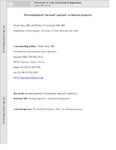 | Couldwell, William T. | The frontotemporal (Pterional) approach: an historical perspective | The frontotemporal, so-called "pterional" approach has evolved with the contribution of many neurosurgeons over the past century. It has stood the test of time and been the most commonly used transcranial approach in neurosurgery. In its current form, drilling the sphenoid wing as far down as the su... | 2012-01-01 | |
| 92 |
 | Couldwell, William T. | Ganglion cyst of the temporomandibular joint with intracranial extension in a patient presenting with seventh cranial nerve palsy | Ganglion cysts arising from the temporomandibular joint are rare entities that often present with swelling and minimal to no pain in the preauricular region. To the Author's? knowledge, a temporomandibular joint ganglion cyst occurring with acute facial nerve palsy and intracranial extension has ne... | 2012 | |
| 93 |
 | Couldwell, William T. | Giant fusiform aneurysm in an adolescent with PHACES syndrome treated with a high-flow external carotid artery-M3 bypass | The acronym PHACES describes a rare neurocutaneous syndrome that comprises posterior fossa malformations, facial hemangiomas, arterial anomalies, coarctation of the aorta and cardiac defects, eye abnormalities, and sternal defects. Facial hemangiomas constitute the hallmark of this disorder. Giant ... | 2007 | |
| 94 |
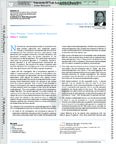 | Couldwell, William T. | Giant pituitary tumor combined approach | Nishioka et al. have provided a review of 29 patients with large pituitary adenomas who underwent surgery through a simultaneous transsphenoidal and transcranial approach at their institution during a 7-year period. Large adenomas with hourglass constriction, complex lobulations, and asymmetric exte... | 2012-01-01 | |
| 95 |
 | Couldwell, William T.; Schmidt, Richard H.; Salzman, Karen L.; Chin, Steven S. | Glioblastoma multiforme of the pineal region | Glioblastoma multiforme (GBMs) tumors are exceedingly rare tumors in the pineal region. We present three cases in which patients presented with a pineal/posterior third ventricular region mass and review all the previously reported cases in the literature. Pineal region GBM seems to be a very aggre... | Glioblastoma multiforme; Hydrocephalus; Leptomeningeal dissemination; Malignant glioma; Perinaud's syndrome; Pineal region; Spinal metastases | 2006 |
| 96 |
 | Couldwell, William T. | Glioma invasion | A characteristic pathological feature of malignant glioma cells is their ability to extensively invade surrounding brain parenchyma-particularly along white matter tracts- thus rendering focal therapies incapable of controlling tumor growth and resulting in inevitable recurrence. In this regard, ... | 2001 | |
| 97 |
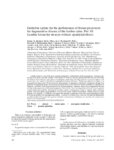 | Dailey, Andrew T. | Guideline update for the performance of fusion procedures for degenerative disease of the lumbar spine. Part 10: Lumbar fusion for stenosis without spondylolisthesis | Lumbar stenosis is one of the more common radiographic manifestations of the aging process, leading to narrowing of the spinal canal and foramen. When stenosis is clinically relevant, patients often describe activity-related low-back or lower-extremity pain, known as neurogenic claudication. For tho... | 2014-01-01 | |
| 98 |
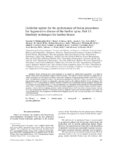 | Dailey, Andrew T. | Guideline update for the performance of fusion procedures for degenerative disease of the lumbar spine. Part 11: Interbody techniques for lumbar fusion | Interbody fusion techniques have been promoted as an adjunct to lumbar fusion procedures in an effort to enhance fusion rates and potentially improve clinical outcome. The medical evidence continues to suggest that interbody techniques are associated with higher fusion rates compared with posterolat... | 2014-01-01 | |
| 99 |
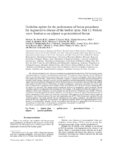 | Dailey, Andrew T. | Guideline update for the performance of fusion procedures for degenerative disease of the lumbar spine. Part 12: Pedicle screw fixation as an adjunct to posterolateral fusion | The utilization of pedicle screw fixation as an adjunct to posterolateral lumbar fusion (PLF) has become routine, but demonstration of a definitive benefit remains problematic. The medical evidence indicates that the addition of pedicle screw fixation to PLF increases fusion rates when assessed with... | 2014-01-01 | |
| 100 |
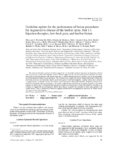 | Dailey, Andrew T. | Guideline update for the performance of fusion procedures for degenerative disease of the lumbar spine. Part 13: Injection therapies, low-back pain, and lumbar fusion | The medical literature continues to fail to support the use of lumbar epidural injections for long-term relief of chronic back pain without radiculopathy. There is limited support for the use of lumbar epidural injections for short-term relief in selected patients with chronic back pain. Lumbar intr... | 2014-01-01 | |
| 101 |
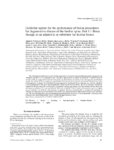 | Dailey, Andrew T. | Guideline update for the performance of fusion procedures for degenerative disease of the lumbar spine. Part 14: Brace therapy as an adjunct to or substitute for lumbar fusion | The utilization of orthotic devices for lumbar degenerative disease has been justified from both a prognostic and therapeutic perspective. As a prognostic tool, bracing is applied prior to surgery to determine if immobilization of the spine leads to symptomatic relief and thus justify the performanc... | 2014-01-01 | |
| 102 |
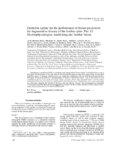 | Dailey, Andrew T. | Guideline update for the performance of fusion procedures for degenerative disease of the lumbar spine. Part 15: Electrophysiological monitoring and lumbar fusion | Intraoperative monitoring (IOM) is commonly used during lumbar fusion surgery for the prevention of nerve root injury. Justification for its use stems from the belief that IOM can prevent nerve root injury during the placement of pedicle screws. A thorough literature review was conducted to determin... | 2014-01-01 | |
| 103 |
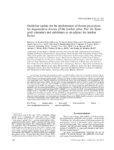 | Dailey, Andrew T. | Guideline update for the performance of fusion procedures for degenerative disease of the lumbar spine. Part 16: Bone graft extenders and substitutes as an adjunct for lumbar fusion | In an attempt to enhance the potential to achieve a solid arthrodesis and avoid the morbidity of harvesting autologous iliac crest bone (AICB) for a lumbar fusion, numerous alternatives have been investigated. The use of these fusion adjuncts has become routine despite a lack of convincing evidence ... | 2014-01-01 | |
| 104 |
 | Dailey, Andrew T. | Guideline update for the performance of fusion procedures for degenerative disease of the lumbar spine. Part 17: Bone growth stimulators as an adjunct for lumbar fusion | The relationship between the formation of a solid arthrodesis and electrical and electromagnetic energy is well established; most of the information on the topic, however, pertains to the healing of long bone fractures. The use of both invasive and noninvasive means to supply this energy and supplem... | 2014-01-01 | |
| 105 |
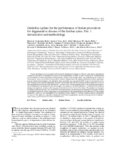 | Dailey, Andrew T. | Guideline update for the performance of fusion procedures for degenerative disease of the lumbar spine. Part 1: Introduction and methodology | Fusion procedures are an accepted and successful management strategy to alleviate pain and/or neurological symptoms associated with degenerative disease of the lumbar spine. In 2005, the first version of the "Guidelines for the performance of fusion procedures for degenerative disease of the lumbar ... | 2014-01-01 | |
| 106 |
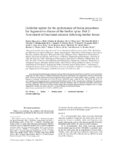 | Dailey, Andrew T. | Guideline update for the performance of fusion procedures for degenerative disease of the lumbar spine. Part 2: Assessment of functional outcome following lumbar fusion | Assessment of functional patient-reported outcome following lumbar spinal fusion continues to be essential for comparing the effectiveness of different treatments for patients presenting with degenerative disease of the lumbar spine. When assessing functional outcome in patients being treated with l... | 2014-01-01 | |
| 107 |
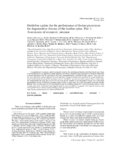 | Dailey, Andrew T. | Guideline update for the performance of fusion procedures for degenerative disease of the lumbar spine. Part 3: Assessment of economic outcome | A comprehensive economic analysis generally involves the calculation of indirect and direct health costs from a societal perspective as opposed to simply reporting costs from a hospital or payer perspective. Hospital charges for a surgical procedure must be converted to cost data when performing a c... | 2014-01-01 | |
| 108 |
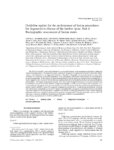 | Dailey, Andrew T. | Guideline update for the performance of fusion procedures for degenerative disease of the lumbar spine. Part 4: Radiographic assessment of fusion status | The ability to identify a successful arthrodesis is an essential element in the management of patients undergoing lumbar fusion procedures. The hypothetical gold standard of intraoperative exploration to identify, under direct observation, a solid arthrodesis is an impractical alternative. Therefore... | 2014-01-01 | |
| 109 |
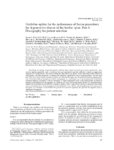 | Dailey, Andrew T. | Guideline update for the performance of fusion procedures for degenerative disease of the lumbar spine. Part 6: Discography for patient selection | Identifying the etiology of pain for patients suffering from chronic low-back pain remains problematic. Noninvasive imaging modalities, used in isolation, have not consistently provided sufficient evidence to support performance of a lumbar fusion. Provocative testing has been used as an adjunct in ... | 2014-01-01 | |
| 110 |
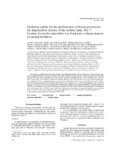 | Dailey, Andrew T. | Guideline update for the performance of fusion procedures for degenerative disease of the lumbar spine. Part 7: Lumbar fusion for intractable low-back pain without stenosis or spondylolisthesis | Establishing an appropriate treatment strategy for patients presenting with low-back pain, in the absence of stenosis or spondylolisthesis, remains a controversial subject. Inherent to this situation is often an inability to adequately identify the source of low-back pain to justify various treatmen... | 2014-01-01 | |
| 111 |
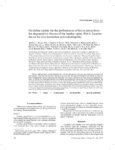 | Dailey, Andrew T. | Guideline update for the performance of fusion procedures for degenerative disease of the lumbar spine. Part 8: Lumbar fusion for disc herniation and radiculopathy | Patients suffering from a lumbar herniated disc will typically present with signs and symptoms consistent with radiculopathy. They may also have low-back pain, however, and the source of this pain is less certain, as it may be from the degenerative process that led to the herniation. The surgical al... | 2014-01-01 | |
| 112 |
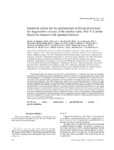 | Dailey, Andrew T. | Guideline update for the performance of fusion procedures for degenerative disease of the lumbar spine. Part 9: Lumbar fusion for stenosis with spondylolisthesis | Patients presenting with stenosis associated with a spondylolisthesis will often describe signs and symptoms consistent with neurogenic claudication, radiculopathy, and/or low-back pain. The primary objective of surgery, when deemed appropriate, is to decompress the neural elements. As a result of t... | 2014-01-01 | |
| 113 |
 | Dailey, Andrew T. | Guidelines for the performance of fusion procedures for degenerative disease of the lumbar spine. Part 10: fusion following decompression in patients with stenosis without spondylolisthesis | Standards. There is insufficient evidence to recommend a treatment standard. Guidelines. There is insufficient evidence to recommend a treatment guideline. Options. 1) In situ posterolateral lumbar fusion is not recommended as a treatment option in patients with lumbar stenosis in whom there is n... | Fusion; Lumbar spine; Degenerative disease; Lumbar fusion | 2005 |
| 114 |
 | Dailey, Andrew T. | Guidelines for the performance of fusion procedures for degenerative disease of the lumbar spine. Part 11: interbody techniques for lumbar fusion | Standards. There is insufficient evidence to recommend a treatment standard. Guidelines. In the context of a single-level stand-alone ALIF or ALIF with posterior instrumentation, the addition of a PLF is not recommended as it increases operating room time and blood loss without influencing the like... | Fusion; Lumbar spine; Degenerative disease; Lumbar fusion; Interbody techniques | 2005 |
| 115 |
 | Dailey, Andrew T. | Guidelines for the performance of fusion procedures for degenerative disease of the lumbar spine. Part 12: pedicle screw fixation as an adjunct to posterolateral fusion for low-back pain | Standard. There is insufficient evidence to recommend a treatment standard. Guidelines. There is insufficient evidence to recommend a treatment guideline. Options. 1) Pedicle screw fixation is recommended as a treatment option for patients with low-back pain treated with PLF who are at high risk... | Fusion procedures; Degenerative disease; Lumbar spine; Pedicle screw fixation; Posterolateral fusion; Low-back pain | 2005 |
| 116 |
 | Dailey, Andrew T. | Guidelines for the performance of fusion procedures for degenerative disease of the lumbar spine. Part 13: injection therapies, low-back pain, and lumbar fusion | Standards. Facet injections are not recommended as long-term treatment for chronic low-back pain. Guidelines. There is insufficient evidence to recommend a treatment guideline. Options. The use of lumbar epidural injections or TPIs is not recommended as a treatment option for long-term relief of c... | Fusion procedures; Degenerative disease; Lumbar spine; Injection therapies; Low-back pain; Lumbar fusion | 2005 |
| 117 |
 | Dailey, Andrew T. | Guidelines for the performance of fusion procedures for degenerative disease of the lumbar spine. Part 14: brace therapy as an adjunct to or substitute for lumbar fusion | Standards. There is insufficient evidence to recommend a treatment standard. Guidelines. The short-term use of a rigid lumbar support (1-3 weeks) is recommended as a treatment for low-back pain of relatively short duration (, 6 months). The use of a lumbar brace for patients with chronic low-back p... | Fusion procedures; Degenerative disease; Lumbar spine; Low-back pain; Lumbar fusion; Brace therapy | 2005 |
| 118 |
 | Dailey, Andrew T. | Guidelines for the performance of fusion procedures for degenerative disease of the lumbar spine. Part 15: electrophysiological monitoring and lumbar fusion | Standards. There is insufficient evidence to recommend a treatment standard. Guidelines. Use of intraoperative SSEP or DSEP monitoring is recommended as an adjunct in those circumstances during instrumented lumbar spinal fusion procedures in which the surgeon desires immediate intraoperative inform... | Fusion procedures; Degenerative disease; Lumbar spine; Low-back pain; Lumbar fusion; Electrophysiological monitoring; EMG | 2005 |
| 119 |
 | Dailey, Andrew T. | Guidelines for the performance of fusion procedures for degenerative disease of the lumbar spine. Part 16: bone graft extenders and substitutes | Standards. The use of autologous bone or rhBMP-2 bone graft substitute is recommended in the setting of an ALIF in conjunction with a threaded titanium cage. Guidelines. There is insufficient evidence to recommend a treatment guideline. Options. 1) Recombinant human BMP-2 in combination with HA ... | Lumbar fusion; Lumbar spine; Bone graft; Treatment outcome; Practice guidelines; Degenerative disease | 2005 |
| 120 |
 | Dailey, Andrew T. | Guidelines for the performance of fusion procedures for degenerative disease of the lumbar spine. Part 17: bone growth stimulators and lumbar fusion | Treatment Standards. There is insufficient evidence to recommend a treatment standard. Treatment Guidelines. Either DCS or CCS is recommended as an adjunct to spinal fusion to increase fusion rates in patients who are at high risk for arthrodesis failure following lumbar PLF. Pulsed electromagnetic... | Fusion procedures; Degenerative disease; Lumbar spine; Lumbar fusion; Bone growth stimulators; Electrical stimulation devices | 2005 |
| 121 |
 | Dailey, Andrew T. | Guidelines for the performance of fusion procedures for degenerative disease of the lumbar spine. Part 1: introduction and methodology | As scientific understanding of the pathophysiology of degenerative disease of the lumbar spine has increased, the possibilities for correcting the underlying problem and the resulting improvement in clinical function have expanded exponentially. Fueled by advances in material technology and surgica... | Lumbar fusion; Lumbar spine; Degenerative disease; Practice guidelines | 2005 |
| 122 |
 | Dailey, Andrew T. | Guidelines for the performance of fusion procedures for degenerative disease of the lumbar spine. Part 2: assessment of functional outcome | Standards. It is recommended that functional outcome be measured in patients treated for low-back pain due to degenerative disease of the lumbar spine by using reliable, valid, and responsive scales. Examples of these scales in the low-back pain population include the following: The Spinal Stenosi... | Lumbar fusion; Lumbar spine; Degenerative disease; Practice guidelines; Treatment outcome; Functional outcome | 2005 |
| 123 |
 | Dailey, Andrew T. | Guidelines for the performance of fusion procedures for degenerative disease of the lumbar spine. Part 3: assessment of economic outcome | Standards. There is insufficient evidence to recommend a standard for assessment of economic outcome following lumbar fusion for degenerative disease. Guidelines. There is insufficient evidence to recommend a guideline for assessment of economic outcome following lumbar fusion for degenerative dis... | Lumbar fusion; Lumbar spine; Degenerative disease; Practice guidelines; Treatment outcome; Economic outcome | 2005 |
| 124 |
 | Dailey, Andrew T. | Guidelines for the performance of fusion procedures for degenerative disease of the lumbar spine. Part 4: radiographic assessment of fusion | Standards. Static lumbar radiographs are not recommended as a stand-alone means to assess fusion status following lumbar arthrodesis surgery. Guidelines. 1) Lateral flexion and extension radiography is recommended as an adjunct to determine the presence of lumbar fusion postoperatively. The lack ... | Lumbar fusion; Lumbar spine; Degenerative disease; Practice guidelines; Radiographic assessment | 2005 |
| 125 |
 | Dailey, Andrew T. | Guidelines for the performance of fusion procedures for degenerative disease of the lumbar spine. Part 5: correlation between radiographic and functional outcome | Standards. There is insufficient evidence to recommend a treatment standard. Guidelines. There is insufficient evidence to recommend a treatment guideline. Options. It is recommended that when performing lumbar arthrodesis for degenerative lumbar disease, strategies to achieve successful radiogr... | Lumbar fusion; Lumbar spine; Degenerative disease; Practice guidelines; Functional outcome; Radiographic outcome | 2005 |
| 126 |
 | Dailey, Andrew T. | Guidelines for the performance of fusion procedures for degenerative disease of the lumbar spine. Part 6: magnetic resonance imaging and discography for patient selection for lumbar fusion | Standards. There is insufficient evidence to recommend a treatment standard. Guidelines. 1) It is recommended that MR imaging be used as a diagnostic test instead of discography for the initial evaluation of patients with chronic low-back pain. 2) It is recommended that MR imaging-documented dis... | Lumbar fusion; Lumbar spine; Degenerative disease; Practice guidelines; Patient selection; Discography | 2005 |
| 127 |
 | Dailey, Andrew T. | Guidelines for the performance of fusion procedures for degenerative disease of the lumbar spine. Part 7: intractable low-back pain without stenosis or spondylolisthesis | Standards. Lumbar fusion is recommended as a treatment for carefully selected patients with disabling lowback pain due to one- or two-level degenerative disease without stenosis or spondylolisthesis. Guidelines. There is insufficient evidence available to support a treatment guideline. Options. An... | Fusion; Lumbar spine; Degenerative disease; Low back pain | 2005 |
| 128 |
 | Dailey, Andrew T. | Guidelines for the performance of fusion procedures for degenerative disease of the lumbar spine. Part 8: lumbar fusion for disc herniation and radiculopathy | Standards. There is insufficient evidence to recommend a treatment standard. Guidelines. There is insufficient evidence to recommend a treatment guideline. Options. 1) Lumbar spinal fusion is not recommended as routine treatment following primary disc excision in patients with a herniated lumbar... | Fusion; Lumbar spine; Degenerative disease; Lumbar fusion; Disc herniation; Radiculopathy | 2005 |
| 129 |
 | Dailey, Andrew T. | Guidelines for the performance of fusion procedures for degenerative disease of the lumbar spine. Part 9: fusion in patients with stenosis and spondylolisthesis | Guidelines. The performance of a lumbar PLF is recommended for patients with lumbar stenosis and associated degenerative spondylolisthesis who require decompression. There is insufficient evidence to recommend a treatment guideline. Options. Pedicle screw fixation as an adjunct to lumbar PLF should ... | Fusion; Lumbar spine; Degenerative disease; Lumbar fusion | 2005 |
| 130 |
 | Couldwell, William T. | Harvey cushing and oskar hirsch: early forefathers of modern transsphenoidal surgery | The transnasal transsphenoidal approach is the preferred route for removal of most lesions of the sella turcica. The concept of transnasal surgery traversing the sphenoid sinus to reach the sella has existed for nearly a century. A comprehensive historical overview of the evolution of transsphenoida... | 2005 | |
| 131 |
 | Couldwell, William T. | Hearing restoration after resection of an intracanalicular vestibular schwannoma: a role for emergency surgery? | Patients with vestibular schwannomas (VSs) most commonly present with sensorineural hearing loss, which is often insidious or gradual. Up to 26% of patients may present with sudden hearing loss, however, which poses an important surgical challenge. Sudden hearing loss has been attributed to spasm or... | Vestibular schwannoma; Hearing preservation | 2002 |
| 132 |
 | Couldwell, William T.; Schloesser, Peter E. | Hemorrhage from moyamoya-like vessels associated with a cerebral arteriovenous malformation | The authors describe a case of subarachnoid hemorrhage from moyamoya-like vessels associated with an arteriovenous malformation (AVM) in a 44-year-old Hispanic man who presented with severe headache. The AVM was located in the left parietal lobe and the ipsilateral middle cerebral artery was occlude... | Moyamoya-like vessels; Arteriovenous malformation; Ischemia MeSH: Arteriovenous malformations | 2004 |
| 133 |
 | Couldwell, William T. | Hemorrhagic and nonhemorrhagic Rathke cleft cysts mimicking pituitary apoplexy | Object. Rathke cleft cysts (RCCs) are infrequently symptomatic, and apoplexy is one of the most unusual presentations. Only a few cases of apoplexy associated with RCCs have been reported, and their clinical, imaging, surgical, and pathological features are poorly understood. In the cases that have ... | 2008-01-01 | |
| 134 |
 | Huang, Lin Eric | HIF-1? mediates tumor hypoxia to confer a perpetual mesenchymal phenotype for malignant progression | Although tumor progression involves genetic and epigenetic alterations to normal cellular biology, the underlying mechanisms of these changes remain obscure. Numerous studies have shown that hypoxia-inducible factor 1? (HIF-1?) is overexpressed in many human cancers and up-regulates a host of hypoxi... | ||
| 135 |
 | Kestle, John R. W. | High incidence of tumor dissemination in myxopapillary ependymoma in pediatric patients | P Myxopapillary ependymomas (MPEs) have historically been thought to be benign tumors occurring most frequently in adults. Only 8 to 20% of these tumors occur in the first two decades of life, making this tumor a rarity in pediatric neurosurgery. Five patients with intraspinal MPEs were treated by t... | 2005-01 | |
| 136 |
 | Kestle, John R. W. | High incidence of tumor dissemination in myxopapillary ependymoma in pediatric patients | P Myxopapillary ependymomas (MPEs) have historically been thought to be benign tumors occurring most frequently in adults. Only 8 to 20% of these tumors occur in the first two decades of life, making this tumor a rarity in pediatric neurosurgery. Five patients with intraspinal MPEs were treated by t... | Myxopapillary ependymoma; Tumor dissemination | 2005 |
| 137 |
 | Couldwell, William T. | History and evolution of transsphenoidal surgery | Initial attempts at transcranial approaches to the pituitary gland in the late 1800s and early 1900s resulted in a mortality rate that was generally considered prohibitive. Schloffer suggested the use of a transsphenoidal route as a safer, alternative approach to the sella turcica. He reported the f... | Neurosurgical history; Transsphenoidal surgery; Pituitary tumor | 2001 |
| 138 |
 | Couldwell, William T. | Hypericin: a potential antiglioma therapy | HYPERICIN, A POLYCYCLIC aromatic dione isolated from plants, is presently being clinically evaluated as an antiviral agent in the treatment of human immunodeficiency virus (HIV) infection. In addition, it is known to be a potent protein kinase C inhibitor. To evaluate its potential as an inhibitor o... | Hypericin; Protein kinase C; Glioma; Brain neoplasm | 1994 |
| 139 |
 | Couldwell, William T.; Osborne, Anne G. | Hypertrophic olivary degeneration after surgical removal of cavernous malformations of the brain stem: report of four cases and review of the literature | Background: Hypertrophic olivary degeneration (HOD) is a pathological phenomenon that occurs after injury to the dentato-olivary pathway. Its hallmarks include hypertrophy of the olive with increased T2 signal intensity on magnetic resonance imaging, and often manifests with palatal tremor and osci... | Hypertrophic olivary degeneration; Surgery; Cavernous malformation; Brainstem | 2008 |
| 140 |
 | Schmidt, Meic H.; MacDonald, Joel D.; Jensen, Randy L.; Couldwell, William T. | Hypophysial transposition (hypophysopexy) for radiosurgical treatment of pituitary tumors involving the cavernous sinus | Stereotactic radiosurgery (SRS) is performed with increasing frequency in the treatment of residual or recurrent pituitary adenomas. Its major associated risk in these cases of residual or recurrent pituitary tumor adjacent to normal functional pituitary gland is radiation exposure to the pituitary,... | Hypophysial transposition; Hypophysopexy; Pituitary tumors; Stereotactic radiosurgery; Pituitary transposition; Hypopituitarism | 2003 |
| 141 |
 | Couldwell, William T.; Schmidt, Meic H.; MacDonald, Joel D.; Jensen, Randy L. | Hypophysial transposition (hypophysopexy) for radiosurgical treatment of pituitary tumors involving the cavernous sinus | Stereotactic radiosurgery (SRS) is performed with increasing frequency in the treatment of residual or recurrent pituitary adenomas. Its major associated risk in these cases of residual or recurrent pituitary tumor adjacent to normal functional pituitary gland is radiation exposure to the pituitary,... | Pituitary tumor; Cavernous sinus; Hypopituitarism; Stereotactic radiosurgery; Transsphenoidal surgery; Pituitary transposition | 2003 |
| 142 |
 | Couldwell, William T.; Gillespie, David L.; Jensen, Randy L. | Identification of hypoxia-induced genes in a malignant glioma cell line (U-251) by cDNA microarray analysis | Overcoming the metabolic restrictions of hypoxia may allow the progression of lower-grade tumors to glioblastoma multiforme. Our findings of up-regulation of HIF-1α and its downstream targets VEGF, GLUT-1, and CAIX in higher-grade gliomas support this hypothesis. We compared the gene expression pro... | Glioblastoma multiforme; U-251; Hypoxia; Microarray analysis; Brain tumor; Depp; Astrocytoma | 2007 |
| 143 |
 | Couldwell, William T. | Immunology and immunotherapy of intrinsic glial tumors | Immunological aspects of glial neoplasms have been actively investigated for the past several years with particular focus on academic, diagnostic, and therapeutic objectives. As more knowledge is acquired about the cellular events relating to tumor behavior the more it appears that the immune system... | Immunology; Glial tumors | 1990 |
| 144 |
 | Couldwell, William T. | Increased invasive capacity of connexin43-overexpressing malignant glioma cells | Object. Malignant glioma cells, similar to astrocytes, express connexin43 (Cx43) universally but at widely varied levels. Data from previous studies have demonstrated that malignant glioma cells form functional gap junction channels among themselves as well as with astrocytes and that such a communi... | 2003-12 | |
| 145 |
 | Couldwell, William T. | Increasing exposure of the petrous internal carotid artery for revascularization using the transzygomatic extended middle fossa approach: a cadaveric morphometric study | When internal carotid artery (ICA) sacrifice is planned in the management of difficult tumors or aneurysms at the cranial base, the petrous ICA may be a useful site for anastomosis for interpositional vascular bypass. However, exposure of the artery and performing an anastomosis in this region may... | Revascularization; Internal carotid artery; Cranial base tumors; Giant aneurysms; Interpositional bypass; Surgical approach; Middle fossa | 2006 |
| 146 |
 | Kestle, John R. W.; Simon, Tamara Danielle | Infection rates following initial cerebrospinal fluid shunt placement across pediatric hospitals in the United States | Object. Reported rates of CSF shunt infection vary widely across studies. The study objective was to determine the CSF shunt infection rates after initial shunt placement at multiple US pediatric hospitals. The authors hypothesized that infection rates between hospitals would vary widely even after ... | Shunt placement; Pediatric neurosurgery | 2009 |
| 147 |
 | Couldwell, William T. | Inflammatory pseudotumor of the cavernous sinus and skull base | Inflammatory pseudotumor is a non-neoplastic process of unknown etiology characterized by a proliferation of connective tissue with an inflammatory infiltrate. Intracranial inflammatory pseudotumors classically involve the cavernous sinus but can also occur in the supratentorial or infratentorial c... | Intracranial neoplasm; Pseudotumor; Skull base | 2006 |
| 148 |
 | Couldwell, William T. | Inhibition of cellular growth and induction of apoptosis in pituitary adenoma cell lines by the protein kinase C inhibitor hypericin: potential therapeutic application | Protein kinase C (PKC) is an enzyme involved in the regulation of cellular growth, proliferation, and differentiation in a number of tissues including the anterior pituitary, in which it is also believed to play a role in hormone secretion. Protein kinase C activity and expression have been found to... | Apoptosis; Hypericin; Pituitary adenoma; Protein kinase C | 1996 |
| 149 |
 | Couldwell, William T. | Inhibition of growth of established human glioma cell lines by modulators of the protein kinase-C system | The protein kinase-C (PKC) second messenger system contributes to regulation of cell growth and differentiation. This study was undertaken to examine the effects of modulators of the PKC enzyme system on the state of differentiation and proliferation rates of human gliomas in vitro. The administrat... | Protein kinase C; Phorbol ester; Cell proliferation; Tumor cell growth; Astrocyte; Glioma; Immunohistochemistry | 1990 |
| 150 |
 | Couldwell, William T. | Initial experience related to the use of the Cosman-Roberts-Wells stereotactic instrument | Initial experience with a new arc-radius design of stereotactic frame that interfaced with the existing components of the Brown-Roberts-Wells instrument is reported. Over a 6-month period, 32 procedures were performed on 23 males and nine female patients (mean age 32 years); these included 27 ster... | Image-directed stereotaxis; Stereotactic instrument; Cosman-Roberts-Wells stereotaxy | 1990 |
| 151 |
 | Dailey, Andrew T.; Brodke, Darrel S. | Inter- and intraobserver reliability of computed tomography in assessment of thoracic pedicle screw placement | Study Design. Reliability study of computed tomography imaging in 12 cadaver specimens instrumented with titanium or stainless steel thoracic pedicle screws. Objective. To evaluate inter- and intraobserver reliability of computed tomography scan in determining the accuracy of thoracic pedicle sc... | Thoracic pedicle screw; Placement; Assessment; Computed tomography | 2003 |
| 152 |
 | Couldwell, William T. | Interpositional dural graft technique for the treatment of dural arteriovenous fistulas | Dural arteriovenous fistulas (dAVFs) are acquired direct arteriovenous shunts that often drain into the dural venous sinus. Treatment options generally involve disrupting the abnormal vascular conduits by using a combination of modalities, including surgical disconnection, radiosurgery, and transar... | 2007 | |
| 153 |
 | Kestle, John R. W. | Intervertebral disc embolization resulting in spinal cord infarction | A case of spinal cord infarction resulting from embolization of fibrocartilaginous intervertebral disc material is presented. Cases from the literature are reviewed and the theories of pathogenesis are discussed. In all reported cases the diagnosis was not made until postmortem examination. | Spinal cord infarction; Nucleus pulposus; Intervertebral disc; Embolization | 1989 |
| 154 |
 | Couldwell, William T. | Intracranial hypotension as a complication of lumbar puncture prior to elective aneurysm clipping | Background: Lumbar dural defects are an uncommon but important cause of persistent intracranial hypotension in the neurosurgical population. We present a case of intracranial hypotension after elective craniotomy due to a lumbar puncture performed 3 weeks earlier. Case Description: A 55‑year‑old... | 2014-01-01 | |
| 155 |
 | Couldwell, William T. | Intracranial hypotension in the setting of concurrent perineural cyst rupture and subarachnoid hemorrhage | Although most patients with intracranial hypotension typically present with headaches, the rest of the clinical spectrum is characteristically non-specific and often quite variable. In a patient with concurrent pathologies that can produce a similar clinical picture, a high index of suspicion must b... | 2013-01-01 | |
| 156 |
 | Dailey, Andrew T. | Intracranial vascular anastomosis using the microanastomotic system | The authors describe the use of a microanastomotic device to perform intracranial end-to-end vascular anastomoses. Direct end-to-end anastomosis was performed between the superficial temporal artery and branches of the middle cerebral artery (MCA) in three patients. Two patients had moyamoya disease... | Microanastomotic system; Intracranial anastomosis; Superficial temporal-middle cerebral artery bypass; Carotid occlusion | 1998 |
| 157 |
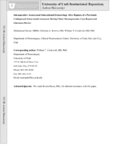 | Couldwell, William T. | Intraoperative aneurysmal subarachnoid hemorrhage after rupture of a previously undiagnosed intracranial aneurysm during Chiari decompression: case report and literature review | Type 1 Chiari malformation occurs when caudal displacement of cerebellar tonsils below the level of foramen magnum obstructs the normal flow of cerebrospinal fluid (CSF) between the cranial and spinal spaces, a condition that often needs surgical decompression to restore normal CSF circulation. Abru... | 2014-01-01 | |
| 158 |
 | Couldwell, William T. | Irving S. Cooper (1922-1985): a pioneer in functional neurosurgery | Irving S. Cooper (1922-1985), the son of a salesman, worked his way through high school, college, and medical school to become one of the pioneers in functional neurosurgery. He developed several novel techniques for the surgical management of Parkinson's disease and other crippling movement disord... | Functional neurosurgery; Cryosurgery; Dystonia; Movement disorder; Parkinson's disease; Thalamotomy; Tremor; Neurosurgical history | 1998 |
| 159 |
 | Couldwell, William T. | Irving S. Cooper and the early surgical management of movement disorders | Irving S. Cooper was a pioneer in the field of functional neurosurgery. During his very productive and controversial career, he proposed the surgical treatment of Parkinson disease (PD) by ligating the anterior choroidal artery to control tremor and rigidity. Subsequently, he developed seminal techn... | Functional neurosurgery; Movement disorder; Video | 2001 |
| 160 |
 | Schmidt, Meic H. | Is vertebral augmentation the right choice for cancer patients with painful vertebral compression fractures? | Cancer-related fractures of the spine are different from osteoporotic ones, not only in pathogenesis but also in natural history and treatment. Higher class evidence now supports offering balloon kyphoplasty to a patient with cancer, provided that the pain is significant in intensity, has a position... | 2012-01-01 | |
| 161 |
 | Schmidt, Meic H. | Isolated intramedullary neurosarcoidosis of the thoracic spine: case report and review of the literature | Sarcoidosis can involve the central nervous system in approximately 5-15% of cases. Any part of the nervous system can be involved, so presentation can be quite varied. Isolated disease of the spinal cord is even less common and reports are limited to single cases and small series. Although in the s... | 2012-01-01 | |
| 162 |
 | Kestle, John R. W. | It's randomized and double blinded... what more do we want? | This issue of Journal of Neurosurgery: Pediatrics presents a randomized trial in which investigators have evaluated antimicrobial suture (AMS) in the prevention of shunt infection. The authors randomized 84 shunt procedures in 61 patients over 21 months. The surgeons and patients were blinded to... | 2008 | |
| 163 |
 | Kestle, John R. W.; Townsend, Jeannette J.; Brockmeyer, Douglas Lee | Juvenile pilocytic astrocytoma of the brainstem in children | Object. In reports involving the operative treatment of brainstem tumors, multiple histological types are often grouped together. To determine prognosis after resection, histology-specific data may be helpful. Methods. Twenty-eight patients with juvenile pilocytic astrocytoma (JPA) of the brainste... | Juvenile pilocytic astrocytoma; JPA; Brainstem tumors; Resection | 2004 |
| 164 |
 | Kestle, John R. W. | Lack of benefit of endoscopic ventriculoperitoneal shunt insertion: a multicenter randomized trial | Object. Endoscopically assisted ventricular catheter placement has been reported to reduce shunt failure in uncontrolled series. The authors investigated the efficacy of this procedure in a prospective multicenter randomized trial. Methods. Children younger than 18 years old who were scheduled for t... | Ventriculoperitoneal shunt; Shunt insertion; Shunt failure | 2003 |
| 165 |
 | Kestle, John R. W. | Late rapid deterioration after endoscopic third ventriculostomy: additional cases and review of the literature | Object. Late rapid deterioration after endoscopic third ventriculostomy (ETV) is a rare complication. The authors previously reported three deaths from three centers. Three other deaths and a patient who experienced rapid deterioration have also been reported. Following the death at the University ... | Endoscopic third ventriculostomy; ETV; Pediatric neurosurgery; Adverse outcome | 2006 |
| 166 |
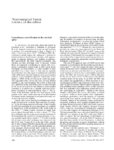 | Dailey, Andrew T. | Lateral mass screw fixation in the cervical spine | To The Editor: We read with interest the article by Kawabata et al.15 (Kawabata S, Watanabe K, Hosogane N, et al: Surgical correction of severe cervical kyphosis in patients with neurofibromatosis Type 1. Report of 3 cases. J Neurosurg Spine 18:274-279, March 2013). Reconstructive spinal surgery has... | 2014-01-01 | |
| 167 |
 | Patel, Bhupendra C. | Lateral orbital wall approach to the cavernous sinus: laboratory investigation | Object. Lesions of the cavernous sinus remain a technical challenge. The most common surgical approaches involve some variation of the standard frontotemporal craniotomy. Here, the authors describe a surgical approach to access the cavernous sinus that involves the removal of the lateral orbital wal... | 2012-01-01 | |
| 168 |
 | Couldwell, William T. | Life-threatening reactions to propofol | To the Editor: Propofol (2,6-diisopropyl phenol; Diprivan; Stuart Pharmaceuticals, Wilmington, DE) has been advocated as a titratable continuous infusion anesthetic agent associated with fast and smooth recovery (2, 7). The anesthetic properties of a smooth induction, short half-life, and rapid eme... | Propofol; Diprivan | 1993 |
| 169 |
 | Schmidt, Meic H. | Light-emitting diodes as a light source for intraoperative photodynamic therapy | THE DEVELOPMENT OF more cost-effective light sources for photodynamic therapy of brain tumors would be of benefit for both research and clinical applications. In this study, the use of light-emitting diode arrays for photodynamic therapy of brain tumors with Pholofrin porfimer sodium was investiga... | Photodynamic therapy; Brain tumors; Brain tumor therapy; Photofrin; LED | 1996 |
| 170 |
 | Couldwell, William T. | Long-term neurological, visual, and endocrine outcomes following transnasal resection of craniopharyngioma | Object. The authors report on a cohort of patients with craniopharyngioma treated principally through transnasal (TN) resection and followed up for a minimum of 5 years. More specifically, they evaluate the role of the TN approach in the management of craniopharyngioma. Methods. Between 1984 and 19... | 2005-04 | |
| 171 |
 | Schmidt, Meic H. | Lumbosacral ependymomas: a review of the management of intradural and extradural tumors | Object. The goal of this study was to review the management of intra- and extradural ependymomas. Spinal ependymomas most commonly occur as intramedullary tumors throughout the spinal axis. In the lumbosacral region, ependymomas are most commonly associated with the conus medullaris and cauda equina... | Intradural ependymoma; Extradural ependymoma; Lumbosacral lesion | 2003 |
| 172 |
 | Dailey, Andrew T. | Magnesium efficacy in a rat spinal cord injury model | Object. Magnesium has been shown to have neuroprotective properties in short-term spinal cord injury (SCI) studies. The authors evaluated the efficacy of magnesium, methylprednisolone, and magnesium plus methylprednisolone in a rat SCI model. Methods. A moderate-to-severe SCI was produced at T9-10 ... | Methylprednisolone; Spinal cord injury; Rat model | 2009 |
| 173 |
 | Dailey, Andrew T. | Magnetic resonance neurography for cervical radiculopathy: a preliminary report | MAGNETIC RESONANCE NEUROGRAPHY was used to directly image cervical spinal nerves in patients with clinical and radiographic evidence of cervical radiculopathy. A magnetic resonance imaging phased-array coil system was used to obtain high-resolution coronal T1-weighted spin echo, coronal/axial T2-wei... | 1996 | |
| 174 |
 | Couldwell, William T. | Malignant glioma-derived soluble factors regulate proliferation of normal adult human astrocytes | Malignant gliomas are characteristically surrounded by marked gliosis. To assess whether glioma-derived products contribute to the proliferation of astrocytes, a feature of the gliosis response, we evaluated the influence of culture supernatants from malignant human glioma lines and tumor cyst fluid... | Astrocyte; Glioma; Gliosis; Proliferation; Soluble factors | 1992 |
| 175 |
 | Couldwell, William T. | Man for all seasons: W.W. Keen | WILLIAM WILLIAMS KEEN was the catalyst for the advent of neurosurgery in the United States. He served in the Civil War and collaborated with Silas Weir Mitchell in studying injuries sustained to the nervous system. These studies culminated in the publication in 1864 of Gunshot Wounds and Other Inj... | Brain tumor | 2002 |
| 176 |
 | Schmidt, Meic H. | Management of brain abscesses associated with halo fixation | Halo orthoses are commonly used in the management of a variety of cervical spinal pathological conditions. Although placement of the cranial pins was initially believed to be safe with minimal complications, minor complications related to the cranial pins have the potential to create a setting for ... | Cerebral abscess; Cranial pin; Halo orthosis; Halo fixation; Inner table of skull | 2008 |
| 177 |
 | Couldwell, William T. | Management of cysticercosis cerebri | Infestation of the central nervous system (CNS) with the parasitic larval form of the cestode Taenia solium, Cysticercosis Cerebri represents an endemic problem in much of the underdeveloped world. In such areas, up to 4% of the population maybe affected by neurocysticercosis, and it accounts for u... | Taenia solium; Cysticercosis Cerebri; Parenchymal cyst; Basilar cisternal cyst; Intraventricular cyst | 1989 |
| 178 |
 | Bisson, Erica F. | Management of distraction injury of the lumbosacral junction with unilateral perched facet | Background: Traumatic unilateral facet dislocation without fracture is an uncommon injury of the lumbosacral junction. We describe a case of a unilateral perched L5-S1 facet causing axial back pain and radiculopathy provoked by motion. ... | Spine surgery, Facet dislocation, operative management, trauma, neurosurgery | 2011-01-04 |
| 179 |
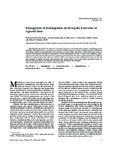 | Couldwell, William T. | Management of meningiomas involving the transverse or sigmoid sinus | Meningiomas that invade the transverse or sigmoid sinuses are uncommon tumors that are challenging to treat surgically. Although the risk of recurrence is associated with the extent of resection, complete removal of meningiomas in these locations must be balanced with avoidance of venous outflow obs... | 2013-01-01 | |
| 180 |
 | Couldwell, William T. | Management of pituitary adenomas | We present an overview of the management of pituitary adenomas, with discussions of microanatomy, of diagnostic studies of general neuroendocrine function, and of radiologic evaluation. We discuss the diagnosis of pituitary adenoma and its treatment with sections on null cell, prolactin (PRL)-secre... | Pituitary adenoma; Transsphenoidal surgery; Corticotropin; Prolactin; Growth hormone; Transcranial surgery | 1994 |
| 181 |
 | Kestle, John R. W. | Management of shunt infections: a multicenter pilot study | Object. Approximately 10% of cerebrospinal fluid (CSF) shunt operations are associated with infection and require removal or externalization of the shunt, in-hospital treatment with antibiotic agents, and insertion of a new shunt. In a previous survey, the authors identified substantial variation i... | Shunt infections; Ventriculoperitoneal shunt; Treatment evaluation | 2006 |
| 182 |
 | Kestle, John R. W.; MacDonald, Joel D.; Schmidt, Richard H. | Marked reduction of cerebral vasospasm with lumbar drainage of cerebrospinal fluid after subarachnoid hemorrhage | Object. Cerebral vasospasm after subarachnoid hemorrhage (SAH) continues to be a major source of morbidity in patients despite significant clinical and basic science research. Efforts to prevent vasospasm by removing spasmogens from the subarachnoid space have produced mixed results. The authors hyp... | Cerebral vasospasm; Lumbar drainage | 2004 |
| 183 |
 | Couldwell, William T. | Medical and surgical management of microprolactinoma | A recent report by Colao et al. [1] indicates that a significant proportion of patients harboring prolactinomas treated with cabergoline will have persistence of remission of hyperprolactinemia following withdrawal of the drug. The prolactin and tumor control rates in the study suggest that medical ... | Microprolactinoma; Prolactinoma; Cabergolene | 2004 |
| 184 |
 | Schmidt, Meic H. | Medical applications of space light-emitting diode technology-space station and beyond | Space light-emitting diode (LED) technology has provided medicine with a new tool capable of delivering light deep into tissues of the body, at wavelengths which are biologically optimal for cancer treatment and wound healing. This LED technology has already flown on Space Shuttle missions, and show... | Photodynamic therapy; Lutetium Texaphyrin; Lutex; Canine glioma | 1999 |
| 185 |
 | Couldwell, William T. | Medpor implant in cranioorbitomaxillary reconstruction: institutional experience and a review of the literature | Autologous materials remain the gold standard for complex skull base and craniofacial reconstruction, but they carry additional morbidity associated with the second harvest procedure and with prolonged operation time. These autologous materials also resorb in a way that is not predictable, rendering... | Medpor; Alloplastic material; Autogenous tissue; Craniofacial reconstruction; Skull base surgery; Methylmethacrylate; Silicone | 2008 |
| 186 |
 | Couldwell, William T. | Metabolic syndrome: what neurosurgeons should know | The term metabolic syndrome, first introduced in 1988, has evolved in concept since that time. While the strict definition is subject to ongoing debate, the syndrome generally involves glucose intolerance, obesity, dyslipidemia and high blood pressure, which increase the risk of developing cardiovas... | 2008-01-01 | |
| 187 |
 | Couldwell, William T. | Metastatic melanoma to the pituitary gland | Metastasis to the pituitary gland is unusual, and occurs most often in patients with carcinomas of the breast or lung. Despite its propensity for spread to the brain, metastatic melanoma has rarely been described within the sella. Methods: We report two cases of malignant melanoma pathologically co... | 2007 | |
| 188 |
 | Schmidt, Meic H. | Minimally invasive thoracoscopic approach for anterior decompression and stabilization of metastatic spine disease | Object. The choices available in the management of metastatic spine disease are complex, and the role of surgical therapy is increasing. Recent studies have indicated that patients treated with direct surgical decompression and stabilization before radiation have better functional outcomes than thos... | Metastatic spine disease; Minimally invasive surgery; Spinal cord decompression | 2008 |
| 189 |
 | Schmidt, Meic H. | Minimally invasive thoracoscopic resection of paraspinal neurogenic tumors: technical case report | OBJECTIVE: The posterior mediastinum is a common location for benign neurogenic tumors. They are frequently asymptomatic but can present with local compressive or neurological symptoms. METHODS: Thoracoscopy is used increasingly over posterolateral thoracotomy for the removal of these lesions. RES... | 2008-01-01 | |
| 190 |
 | Dailey, Andrew T. | Modulation of macrophage and microglial responses to axonal injury in the peripheral and central nervous systems | OBJECTIVE: After axonal injury, macrophages rapidly infiltrate and become activated in the mammalian peripheral nervous system (PNS) but not the central nervous system (CNS). We used the dorsal root pathway to study factors that modulate the response of macrophages to degenerating axons in both the ... | Axonal injury; Macrophage response; Microglial response; Peripheral nervous system; Lewis rats | 1999 |
| 191 |
 | Couldwell, William T.; Viskochil, David H.; Fults, Daniel Webster | Molecular, genetic, and cellular pathogenesis of neurofibromas and surgical implications | NEUROFIBROMATOSIS 1 (NF1) IS A common autosomal dominant disease characterized by complex and multicellular neurofibroma tumors. Significant advances have been made in the research of the cellular, genetic, and molecular biology of NF1. The NF1 gene was identified by positional cloning. The function... | Loss of heterozygosity; Malignant peripheral nerve sheath tumor; Plexiform Neurofibroma; Spinal neurofibroma | 2006 |
| 192 |
 | Kestle, John R. W. | Moyamoya phenomenon after radiation for optic glioma | The role of radiotherapy in the management of patients with optic pathway glioma is controversial. In a series of patients with optic pathway glioma treated at The Hospital for Sick Children in Toronto, five children were encountered who developed moyamoya phenomenon after radiotherapy. A retrospec... | Optic pathway glioma | 1993 |
| 193 |
 | Kestle, John R. W. | Multicenter prospective cohort study of the Strata valve for the management of hydrocephalus in pediatric patients | Object. Previous reports suggest that adjustable valves may improve the survival of cerebrospinal fluid shunts or relieve shunt-related symptoms. To evaluate these claims, the authors conducted a prospective multicenter cohort study of children who underwent placement of Strata valves. Methods. Pat... | Ventriculoperitoneal shunt; Strata valve; Adjustable valves; Pediatric neurosurgery | 2005 |
| 194 |
 | Couldwell, William T. | Multifocal inflammatory leukoencephalopathy associated with levamisole and 5-fluorouracil: case report | LEVAMISOLE AND 5-FLUOROURACIL have now become the standard chemotherapeutic regimen for patients with Stage 111 colon carcinoma. A case of multifocal inflammatory leukoencephalopathy secondary to levamisole alone or combination of levamisole and 5-fluorouracil is reported. Magnetic resonance imaging... | Autopsy; Levamisole; Multifocal inflammatory leukoencephalopathy | 1994 |
| 195 |
 | Schmidt, Meic H. | NASA light-emitting diode medical program-progress in space flight and terrestrial applications | This work is supported and managed through the NASA Marshall Space Flight Center - SBIR Program. Studies on cells exposed to microgravity and hypergravity indicate that human cells need gravity to stimulate cell growth. As the gravitational force increases or decreases, the cell function responds in... | Terrestrial applications; Cell growth; NASA; Microgravity environment | 2000 |
| 196 |
 | Kestle, John R. W. | Natural history of cerebral cavernous malformations | To determine the natural history of brain cavernous malformations, the authors entered patients referred to their center into a prospective registry between 1987 and 1993. All patients underwent magnetic resonance imaging, which showed the typical appearance of this lesion, and conservative manageme... | Cavernous malformation; Vascular malformation; Seizure | 1995 |
| 197 |
 | Couldwell, William T.; Nelson, Don Harry | Nelson syndrome: historical perspectives and current concepts | The appearance of an adrenocorticotropic hormone (ACTH)-producing tumor after bilateral adrenalectomy for Cushing disease was first described by Nelson in 1958. The syndrome that now bears his name was characterized by hyperpigmentation, a sellar mass, and increased plasma ACTH levels. The treatment... | 2007-01-01 | |
| 198 |
 | Schmidt, Meic H.; Schmidt, Richard H. | Nerve sheath tumors involving the sacrum | Nerve sheath tumors that involve the sacrum are rare. Delayed presentation is common because of their slow-growing nature, the permissive surrounding anatomical environment, and nonspecific symptoms. Consequently, these tumors are usually of considerable size at the time of diagnosis. The authors di... | Nerve sheath tumor; Schwannoma | 2003 |
| 199 |
 | Digre, Kathleen B.; Skuster, Denise Z. | Neurologic conditions presenting as psychiatric disorders. | Understanding underlying neuroanatomic function helps physicians to localize defects and search for treatable neurologic conditions. Neurologic conditions such as Huntington's chorea, Wilson's disease, Gille de la Tourette syndrome, brain tumors, encephalitis and meningitis, neurodegenerative condit... | Psychiatric Diagnosis; Neurologic Disease | 1992-06-15 |
| 200 |
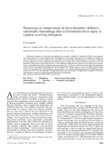 | Garber, Sarah | Neurosurgical complications of direct thrombin inhibitors - catastrophic hemorrhage after mild traumatic brain injury in a patient receiving dabigatran | Dabigatran etexilate is an oral anticoagulant that acts as a direct, competitive thrombin inhibitor. Large randomized clinical trials have shown higher doses of dabigatran (150 mg taken twice daily) to be superior to warfarin in terms of stroke and systemic embolism rates in patients with nonvalvula... | 2012-01-01 |
